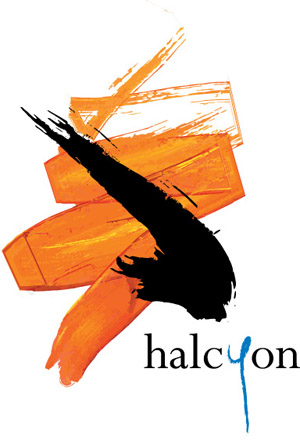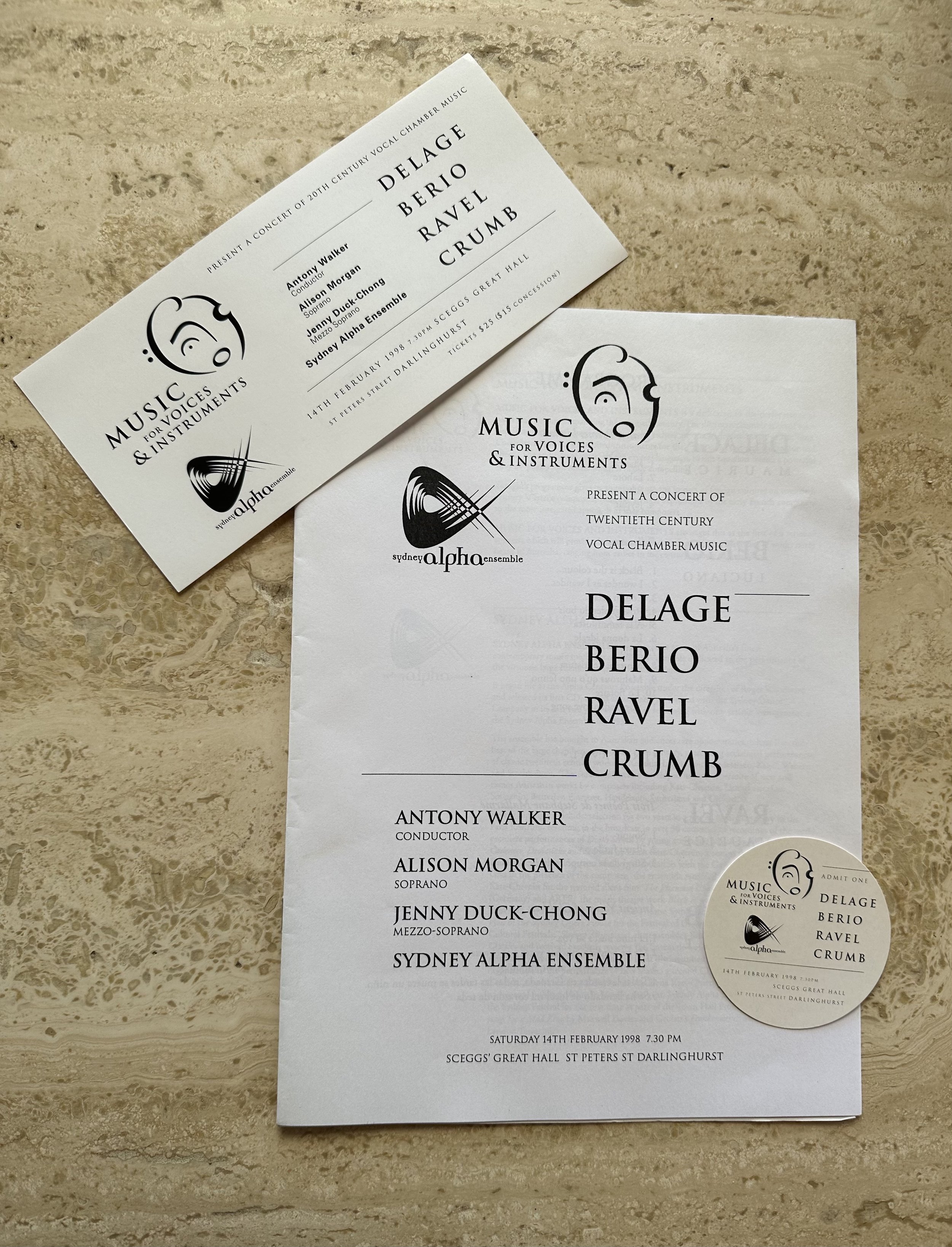In a series of blogs in 2023, Halcyon’s Artist Director, mezzo-soprano Jenny Duck-Chong, considers highlights of the last 25 years. Shining a spotlight on performances month-by-month she shares insights and links to music performed across the years.
April: 2009 and 2012
Continuing to focus on April performances, alongside the Aurora Festival and multiple performances of Steve Reich (see April Pt 1) April also saw us featured in the House Concert series at Government House, Sydney and in a collaborative performance with Sydney Philharmonia's VOX at the Sydney Conservatorium.
19 April 2009 Government House - House Concert
One of several concerts we played at Sydney's Government House in its intimate House Concerts series, this one featured a collection of works for voices, flute, cello, piano - with Laura Chislett flute, Patrick Murphy cello and Sally Whitwell piano.
The lush program was a best-of collection with works by Claire Jordan, John Corigliano, Libby Larsen, John Tavener, Ross Edwards, Oliver Knussen, Joseph Schwantner and Anne Boyd drawn from previous performances.
Claire Jordan's Memory was our first ever commission, premiered in our first concert series in 2001. Inspired by the poetry of Christina Rossetti, it was a song cycle in five movements, soprano and mezzo alternating solos before a final shared duet.
Alison had performed the John Corigliano work in an early vocal chamber music program, devised by the two of us years before the start of Halcyon, way back in 1993. Take a look at the flyer and you can see the kernel of things to come... (and how far computer graphics have changed since then!)
Libby Larsen was another discovery through personal research - perhaps found through perusing publisher catalogues or even books of repertoire lists, like this one from my library. Knussen, Tavener and Schwantner were well established composers even then, who were known for their larger scale vocal music, but we wanted to showcase more of their intimate chamber music.
Finding this underperformed repertoire, especially viewing scores, was a challenge in those days but we worked with publisher representatives and music libraries around the world in the pursuit of high-calibre-but-new-to-us work to perform. There are so many composers who are well known in their own sphere but have less exposure outside their immediate or national reach. I am very proud of the number of composers we have been able to introduce to our audiences across the years and the number of Australian premieres we have presented through this sort of tenacious pursuit.
You can now listen to many of these pieces from our early recordings on YouTube - the Schwantner and Jordan from our very first Demo recording made back in 2002, the Knussen from Earth Jewels in 2003 and the Larsen from Close Ups in 2004.
I remember Larsen’s duo, Liebeslied, as one of those moments of equal partnership between voice and instrument, where each are so beautifully intertwined. The program was performed and recorded live at Trackdown Scoring Stage at Moore Park, Sydney. Our first introduction to the studio where many of our albums have since been recorded, it was the start of a long and productive relationship.
LISTENING LINKS
Claire Jordan Echo from Memory
Joseph Schwantner Black Anemones from Two poems of Aguedo Pizzaro
Oliver Knussen When First I Heard the Learn'd Astronomer from Whitman Songs
Libby Larsen Do You Know and Liebeslied from Beloved, Thou Hast Brought Me Many Flowers
A wonderful chance to work with this enthusiastic ensemble of young voices and their conductor Elizabeth Scott. Presenting works for voice and choir, as well as featuring each ensemble individually, it was a world tour of the rare and the familiar - with works by Arvo Pärt, Katy Abbott, Elliott Gyger, Dan Walker, Kerry Andrew, and Kaija Saariaho. Percussionist Claire Edwards joined us for works by Jorge Vidales, Ross Edwards and a solo piece, Coil by Gerard Brophy (featured on her album of the same name)
Every program is full of wonderful works and stories but here are a few highlights.
By this stage we had performed quite a number of Kerry Andrew's solo and trio pieces. Herself a singer and a member of the female vocal trio, juice, she was already one of Halcyon's ten most performed composers (see the photos on the top of The Music page to discover the rest). We featured two works from her Dusk Songs - O Nata Lux for choir and Criosda liom a cadal for choir with mezzo soloist. The latter, an atmospheric and evocative work saw with the choir spread around the gallery in Verbrugghen Hall at the Sydney Conservatorium, surrounding the audience from above and singing back to me on stage. The choir's vocal entries are 'triggered' by my part. First reponding with my consonant sounds and then gradually with more and more pitches drawn from my melody the sound grows until they are sustaining chords beneath my repeated chant-like melody.
Mexican composer Jorge Vidales' Four Basho Haiku (2008) was another internet discovery as we looked for works to complete the program. For solo soprano and vibraphone, Halcyon performed the Australian premiere.
Kaija Saariaho, feted as "among the most prominent composers of the 21st century" was another of Halcyon's most programmed composers. She had such an exceptional understanding of the capacity of the human voice and loved to explore its textural possibilities, forming text collages and using sound as much for meaning to convey her intent.
She is quoted, in an interview with NPR, as saying,
"I think that sound and color are not completely detached from each other. That's maybe how it is in our brain. And I think that certain sounds, or certain kinds of music, can have even a specific smell. So I feel that all the senses are somehow present when I compose."
Read the full article here.
Sadly she passed away earlier this year and the world lost a unique and influential composer. In the 25th birthday program which featured her Ariel’s Hail (from The Tempest Songbook), I noted:
”A giant of contemporary vocal music, Saariaho’s distinctive work has featured in numerous Halcyon programs since we first performed Grammaire des Reves in 2002. Exploring the intricacies and timbres of that score and its vocal writing with my then co-director, Alison Morgan, was revelatory and viscerally exciting and solidified our vocal partnership as we wove words, phrases and even syllables together and merged with, or emerged from, the instrumental textures around us. Performing that work strongly influenced the repertoire we selected in the ensuing years and the vocal virtuosity that we wanted to challenge ourselves with in the future.”
By 2012 we had already presented six of her works in concert: Grammaire des Rêves (2002 & 2005) Du gick, flög and Nej och inte (2004), The (complete) Tempest Songbook (2007), Miranda's Lament from the Songbook (2008) Quatres messages (2010) and Nuits, Adieux (2010) with electronics. The instrumental work Cendres also featured in an early collaborative program with Ensemble Offspring.
Nuits, adieux originally featured in our atmospheres program, a collaborative program of electro-acoustic music with austraLYSIS as part of the New Music Network* concert series in 2010. When we were planning this program, we remembered that the piece, which we had so enjoyed performing, also existed in a version for solo voices and choir. As the program note states: "The mixed choir replaces and imitates the electronics of the original. The various echoes, delays and other effects have been transferred to the choir part."
Joined by the two male soloists from the first performance - tenor Andrei Laptev and bass Clive Birch - it was fascinating for us all to return to a piece that was the same… but different. Instead of microphones and electronics, we had the choristers, magnifying and extending sonorities from the solo parts. For them, it was really an exercise in both reading and listening intently, responding to their corresponding solo voice.
You can read Saariaho's full program note and texts here
LISTENING LINKS
Jorge Vidales Four Basho Haiku
Kaija Saariaho Nuits Adieux (with Sydney Philharmonia's VOX)
Kerry Andrew Criosda liom a cadal performed by the Ebor Singers
* For those of you who don't know about the New Music Network, you can read a bit more about what it was in this article, written in 2014 by James Nightingale for The Music Trust's Music in Australia Knowledge Base when he was President of the Network. The concert series was an important connection point for members and we were often encouraged to collaborate in our programs for the series which led to the 2013 project with austraLYSIS and one of our few forays beyond the realm of purely acoustic performance.










